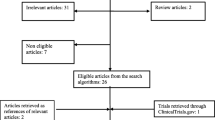Abstract
Background GBC is a rare disease and chemotherapy in this setting lacks a standardized approach. Patients and Methods Patients 16–30 weeks pregnant with locally advanced/metastatic disease or with high risk of recurrence after surgery were evaluated. Results Twenty patients received weekly epirubicin 35 mg/m2. Median maternal age was 37 years (23–42). Median gestational age at chemotherapy was 19 weeks. Thirteen patients were treated after surgery while 7 had locally advanced tumours of which one had liver metastases. Mean total epirubicin dose was 420 mg/m2 with a median number of 12 administrations (4–16). No grade 3–4 toxicities were observed. No foetal adverse events were observed except 1 premature delivery at 28 weeks. Births were induced by caesarean section in 12 patients at a median gestational age of 35 weeks. No malformations were reported except 1 newborn with polycystic kidney. At a median age of 2 years, neurological, cardiological and immunological development was normal in all children as reported by their parents. In 7/20 patients with evaluable disease, five had an objective response. At a median follow-up of 38 months, 17 patients are alive; 14 are disease free. Conclusions Weekly epirubicin appears safe and effective with low foetal toxicity and could be considered in GBC.
Similar content being viewed by others
References
Parkin DM, Bray F, Ferlay J, Pisani P (2005) Global cancer statistics, 2002. CA Cancer J Clin 55:74–108
Berkowitz GS, Skovron ML, Lapinski RH, Berkowitz RL (1990) Delayed childbearing and the outcome of pregnancy. N Engl J Med 322:639–664
Haas JF (1989) Pregnancy is association with newly-diagnosed cancer: a population-based epidemiologic assessment. Int J Cancer 34:229–235. doi:10.1002/ijc.2910340214
Loibl S, von Minckwitz G, Gwtn K, Ellis P, Blohmer JU, Schlegelberger B et al (2006) Breast carcinoma during pregnancy. International recommendations from an expert meeting. Cancer 106:237–246. doi:10.1002/cncr.21610
Boldrini R, Di Cesare M, Tamburini C (eds) (2007) Rapporto CeDAP, 2004. Italian Ministry of Health website (www.ministerosalute.it)
Ring AE, Smith IE, Jones A, Shannon C, Galani E, Ellis PA (2005) Chemotherapy for breast cancer during pregnancy: an 18-year experience from five London teaching hospitals. J Clin Oncol 23:4192–4197. doi:10.1200/JCO.2005.03.038
Cardonick E, Iacobucci A (2004) Use of chemotherapy during human pregnancy. Lancet Oncol 5:283–291. doi:10.1016/S1470-2045(04)01466-4
Cohen-Kerem R, Railton C, Oren D, Lishner M, Koren G (2005) Pregnancy outcome following non-obstetric surgical intervention. Am J Surg 190:467–473. doi:10.1016/j.amjsurg.2005.03.033
Orecchia R, Lucignani G, Tosi G (2008) Prenatal irradiation and pregnancy: the effects of diagnostic imaging and radiation therapy. Recent Results Cancer Res 178:3–20. doi:10.1007/978-3-540-71274-9_2
Doll DC, Ringenberg QS, Yarbo JW (1989) Antineoplastic agents and pregnancy. Semin Oncol 16:337–346
Zemlickis D, Lishner M, Degendorfer P, Panzarella T, Sutcliffe SB, Koren G (1992) Fetal outcome after in utero exposure to cancer chemotherapy. Arch Intern Med 152:573–576. doi:10.1001/archinte.152.3.573
Barthelmes L, Davidson LA, Gaffney C, Gateley CA (2005) Pregnancy and breast cancer. BMJ 330:1375–1378. doi:10.1136/bmj.330.7504.1375
Bonadonna G, Gianni L, Santoro A, Bonfante V, Bidoli P, Casali P et al (1993) Drugs ten years later: epirubicin. Ann Oncol 4:359–369
Twelves CJ, O’Reilly SM, Coleman RE, Richards MA, Rubens RD (1989) Weekly epirubicin for breast cancer liver metastasis and abnormal liver biochemistry. Br J Cancer 60:938–941
Goldhirsch A, Wood WC, Gelber RD, Coates AS, Thurlimann B, Senn HJ (2007) Progress and promise: highlights of the international expert consensus on the primary therapy of early breast cancer 2007. Ann Oncol 18:1133–1144. doi:10.1093/annonc/mdm271
Myers C (1988) Role of iron in anthracycline action. In: Hacker M, Lazo J, Tritton T (eds) Organ directed toxicities of anticancer drugs. Martinus Nijhoff, Boston, Mass, pp 17–30
Clapp C, Thebault S, Martinez de la Escalera G (2007) Hormones and pospartum cardiomyopathy. Trends Endocrinol Metab 18:329–330. doi:10.1016/j.tem.2007.08.004
Yeh ET, Tong AT, Lenihan DJ, Yusuf SW, Swafford J, Champion C et al (2004) Cardiovascular complications of cancer therapy: diagnosis, pathogenesis, and management. Circulation 109:3122–3131. doi:10.1161/01.CIR.0000133187.74800.B9
Hahn KM, Johnson PH, Gordon N, Kuerer H, Middleton L, Ramirez M et al (2006) Treatment of pregnant breast cancer patients and outcomes of children exposed to chemotherapy in utero. Cancer 107:1219–1226. doi:10.1002/cncr.22081
Camaggi CM, Strocchi E, Comparsi R, Testoni F, Angelelli B, Pannuti F (1986) Biliary excretion and pharmacokinetics of 4′epidoxorubicin (epirubicin) in advanced cancer patients. Cancer Chemother Pharmacol 18:47–50. doi:10.1007/BF00253063
Kushari J, Mukherjea M (1980) Studies on beta-glucuronidase of the developing human placenta. Gynecol Obstet Invest 11:119–127
Peccatori F, Martinelli G, Gentilini O, Goldhirsch A (2004) Chemotherapy during pregnancy: what is really safe? Lancet Oncol 5:398. doi:10.1016/S1470-2045(04)01506-2
Partridge AH, Garber JE (2000) Long-term outcomes of children exposed to antineoplastic agents in utero. Semin Oncol 27:712–726
Gwyn K (2005) Children exposed to chemotherapy in utero. J Natl Cancer Inst Monogr 34:69–71. doi:10.1093/jncimonographs/lgi009
Aviles A, Neri N, Nambo MJ (2006) Long-term evaluation of cardiac function in children who received anthracyclines during pregnancy. Ann Oncol 17:286–288. doi:10.1093/annonc/mdj053
Author information
Authors and Affiliations
Corresponding author
Additional information
Fedro A. Peccatori and Hatem A. Azim Jr contributed equally to the work.
Rights and permissions
About this article
Cite this article
Peccatori, F.A., Azim, H.A., Scarfone, G. et al. Weekly epirubicin in the treatment of gestational breast cancer (GBC). Breast Cancer Res Treat 115, 591–594 (2009). https://doi.org/10.1007/s10549-008-0159-2
Received:
Accepted:
Published:
Issue Date:
DOI: https://doi.org/10.1007/s10549-008-0159-2




